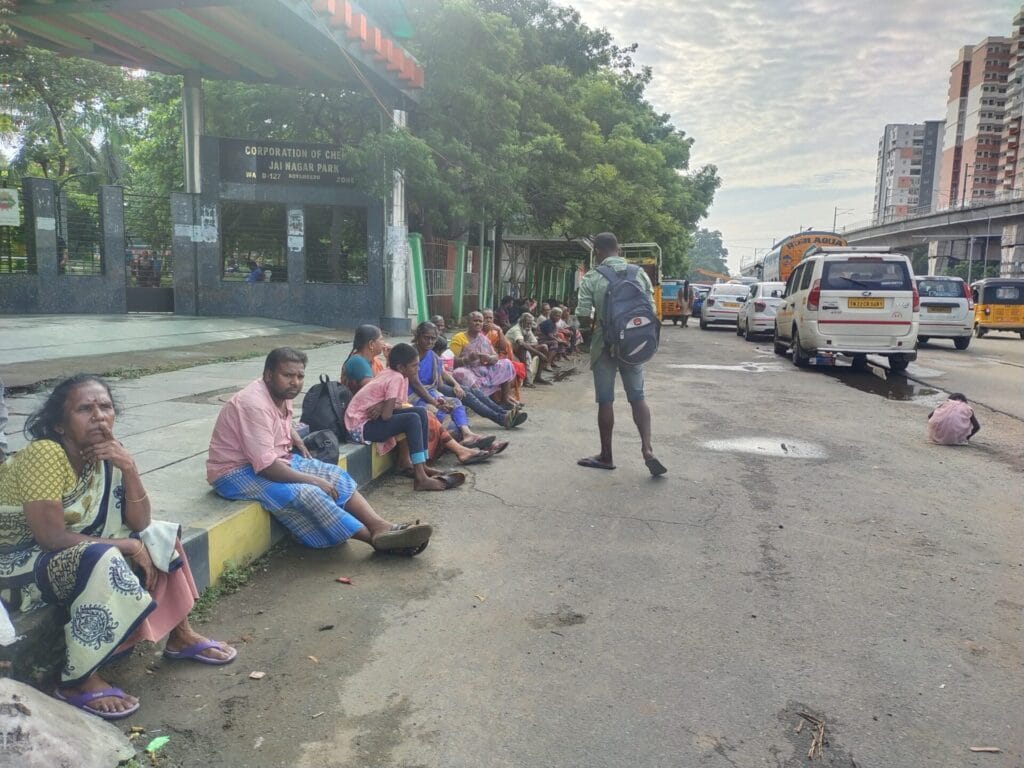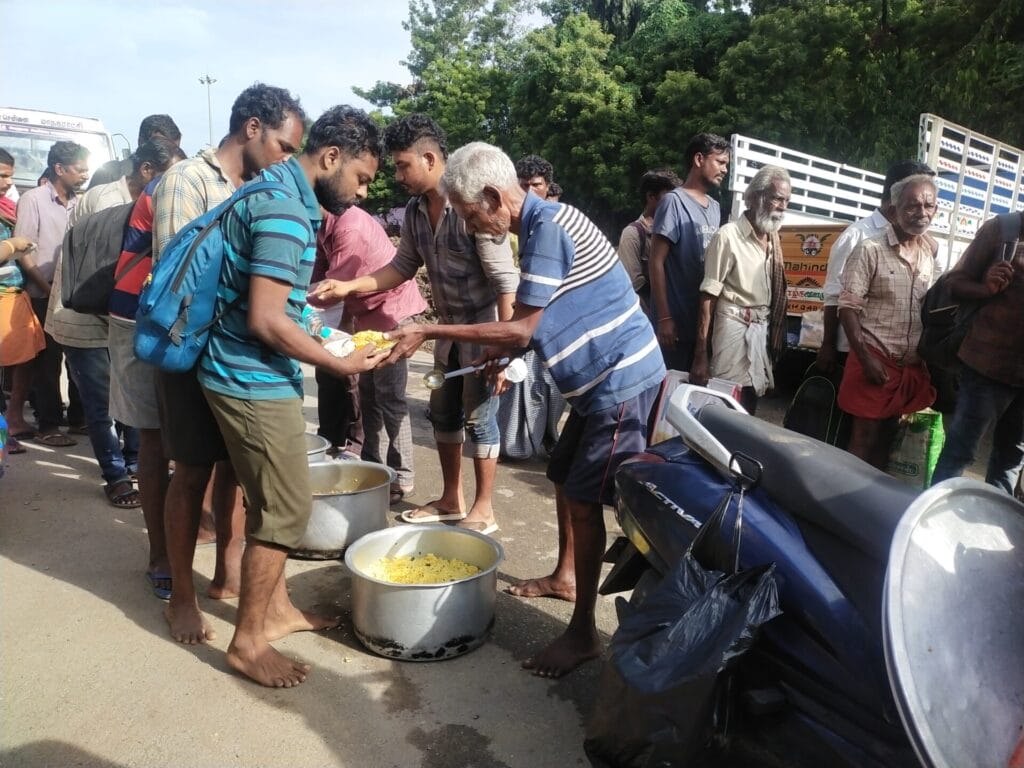Akbar Hussain, a 60-year-old who lives with his wife inside the Koyambedu bus stand, waits in line amidst tens of labourers in Koyambedu for his turn to be called for work. “If I come and stand in this line, there is a chance of me finding a job for the day and there is also a certainty that I will find food for me and my wife,” he says.
A native of Kallakuruchi, Akbar was working in a tea shop until COVID-19. As the tea shop was closed during the pandemic, Akbar and his wife found it difficult to make ends meet. The first wave of COVID-19 made them homeless. “We could not afford the rent and so our house owner forced us out of the house. Our children also abandoned us. We had nowhere to go. So, we boarded a lorry and came to Chennai in search of a job,” says Akbar.
The Tamil saying ‘Vandharai Vazhavaikum Chennai‘ refers to Chennai as a city that gives life to anyone who comes here. The ‘labour stands’ such as the one Akbar waits at in Koyambedu and more such spots in Perambur, Padi, Vadapalani, ECR and Thiruvanmaiyur help migrant workers find a living and make a home in Chennai.
For workers, these points are a place of opportunity to find a job that will help them eke out a living, at least for the day. However, for the contractors, these points are a key ‘labour market’ where they handpick the workers they need, most times for less than minimum wage.
Read more: This May Day, let us listen to the plight of workers in Chennai
Functioning of labour stands in Chennai
Many people like Akbar who are mostly homeless and street dwellers, start gathering at their nearest labour stand in the city as early as 6.30 am. Most of these labour stands are located near bus stands or important junctions in the city. By around 7 am, a few non-governmental organisations that provide free breakfast to the workers start distributing food.
As this happens on one side, people who hire them on behalf of the contractors for jobs ranging from construction to cinema, arrive in mini trucks. There is no set time for these trucks which come anytime between 7 am and 12.30 pm. As they scan through the workers standing in a line, they slow the trucks down and look out for potential workers.
“They will announce the work and ask who is qualified for the work. Certain work requires skilled workers. Other works only require physical strength. They will pick the workers accordingly and tell them the fixed wage for the day. There is no paperwork for this. The financial transactions will be done in cash. At the end of the day, the workers will be paid in cash and they will have to find their way back to the areas they were picked up from,” explains Akbar.
Nagarajan, another worker in the labour stands near the Perambur bus stand, says that some of the workers know the trucks that show up regularly. “If we make ourselves familiar with such regular trucks, it is easy to get jobs. But, the very nature of this labour stands is the uncertainty of getting a job,” he says.
When asked why he prefers to come to the labour stands to find work for the day rather than a job that provides fixed wages, he says, “I am not educated and so I cannot find a regular job that pays every month. We cannot afford a rental house. We live on the street. While we are already finding it hard to make ends meet on a day-to-day basis, how will we be able to survive on a monthly salary? Now, we earn one day and survive with it for the next few days until we find the job again. Besides, we also get food at these labour points.”
Exploitation of vulnerable groups in labour stands of Chennai
The workers in these labour stands in Chennai are hired for a range of work including laying roads, cleaning septic tanks, cleaning sewage lines, painting buildings, catering services, construction works, driving four-wheelers and working on cinema production.
Ponni, a worker in Koyambedu, says that the trucks that hire workers also take people for work to cinema shooting spots. “Sometimes they hire men for decorating sets for cinema shoots, for which they will pay Rs 800 to Rs 900. Somedays, they hire a mixed group of people including the children to shoot scenes relating to crowds in movies like a fight sequence taking place in public. We will be asked to do some random things in the background. For this, they will pay us Rs 400 to Rs 450 a day in addition to serving us food,” she notes.
Ponni says that the average pay for men in these labour stands is from Rs 800 to Rs 1,300 per day, while the average pay for women in the same places is Rs 400 to Rs 500 a day. “The contractors or the middlemen who hire us for work will get at least Rs 1,000 per worker but we are not given the same amount. Of the total crowd in the labour stands, only 10% of them will be women as those hiring the workers prefer men over women for jobs. Women get jobs like cleaning toilets in some buildings, cleaning vessels in hotels or marriage halls, while men get hired for all other jobs,” she says, explaining that women do not find good job opportunities or decent pay in the labour stands of Chennai.
Akbar also notes that most of the trucks do not pick up senior citizens for work as they think they cannot get the work done.
While women and senior citizens, who fall under the vulnerable categories, are not considered potential workers, children are hired in these labour stands for cinema shoot related work quite often.
Ponni says that children join the labour stands on school holidays and weekends. They accompany the parents mostly for jobs involving cinema shoots. “The children find cinema shoots very fascinating. We cannot afford to take them to movies in theatres. The least we can do is to use these opportunities and show them what happens behind the scenes. When the children join us for work in the cinema sets, we get free food for them as well,” Ponni adds.
In India, a “Child” as defined by the Child Labour (Prohibition and Regulation) Amendment Act of 2016 is a person who has not completed 14 years of age. If any person employs a child below the age of 14 or between ages 14 to 18 years in a hazardous occupation or process can be punished with jail time between one to six months and/or a fine between 20,000 to 50, 000. If you come across any child forced or engaged in child labour, report to your nearest police station or call CHILDLINE on 1098.
Relationship with the contractors
When asked if the workers knew who they worked for on the jobs they found through the labour stands, almost everyone unanimously said that they had no idea about that. “We only know the middlemen who deal with us. We do not know who the contractor is or who our principal employer is,” they say.
Given the nature of how they are selected for the job, they say that they do not have a fixed employer. “We will get a job one day and we might not get the same job or any other job for the next few days,” say the workers.
The workers point out that there are many cases where the middlemen who hire them fail to pay them the promised amount. They also note that when they work in hazardous environments like cleaning sewage or road work, they are not given any safety gear. “We do not know what safety gear is. No one has given any such thing so far. We will only be asked to do the work. They will provide us with food and a day’s pay. That is all the interaction we have with the employers,” say the workers.
“They would have promised Rs 400 per day but by the end of the day, they would only give us Rs 200. Since we do not have the strength to argue or fight with them for the rightfully earned money, we give up and get the money they give,” adds Ponni.
On average Ponni gets jobs for 7 to 10 days in a month, while many men in the labour stands are able to find jobs for 8 to 15 days in a month.
Interestingly, while the food trucks from the NGOs that serve breakfast at these labour stands come across as a philanthropic service at the outset, interaction with the representatives of the NGOs shows that these NGOs hold power over the workers by serving them food. “When hotels or marriage halls ask for catering services, we supply them with workers,” they say.
Read more: Temporary workers keep Chennai going at great personal cost
Institutional help required at labour stands
The workers in the labour stands form a major workforce in the unorganised sector in Chennai. When asked if any government agency such as the Labour Department or any labour union has tried to reach out to them to help them, the workers reply in the negative.

In addition to the occupational health hazards that they face, which are often not addressed, they also tend to stand for long hours in scorching sun and pouring rain just so they might get a job. This shows the need to acknowledge these labour stands and provide basic amenities like shelters, water and toilets in these places.
Given the exploitative nature of the jobs, there is a dire need to regularise the contractor-worker relationship in the labour stands to ensure that the workers’ rights are protected and issues like rampant child labour are addressed.
The Working Peoples Coalition (WPC) network, a coalition of organizations working on issues related to informal labour in particular and labour in general, has set up an all-India national Mediation and Legal Aid Centre with links in different states to help workers, especially migrant workers, to ask for help with the issues they may be facing at their places of work, and to provide information that can help them access their entitlements. The workers can reach out to India Labourline at 1-800-833-9020 for any help.
